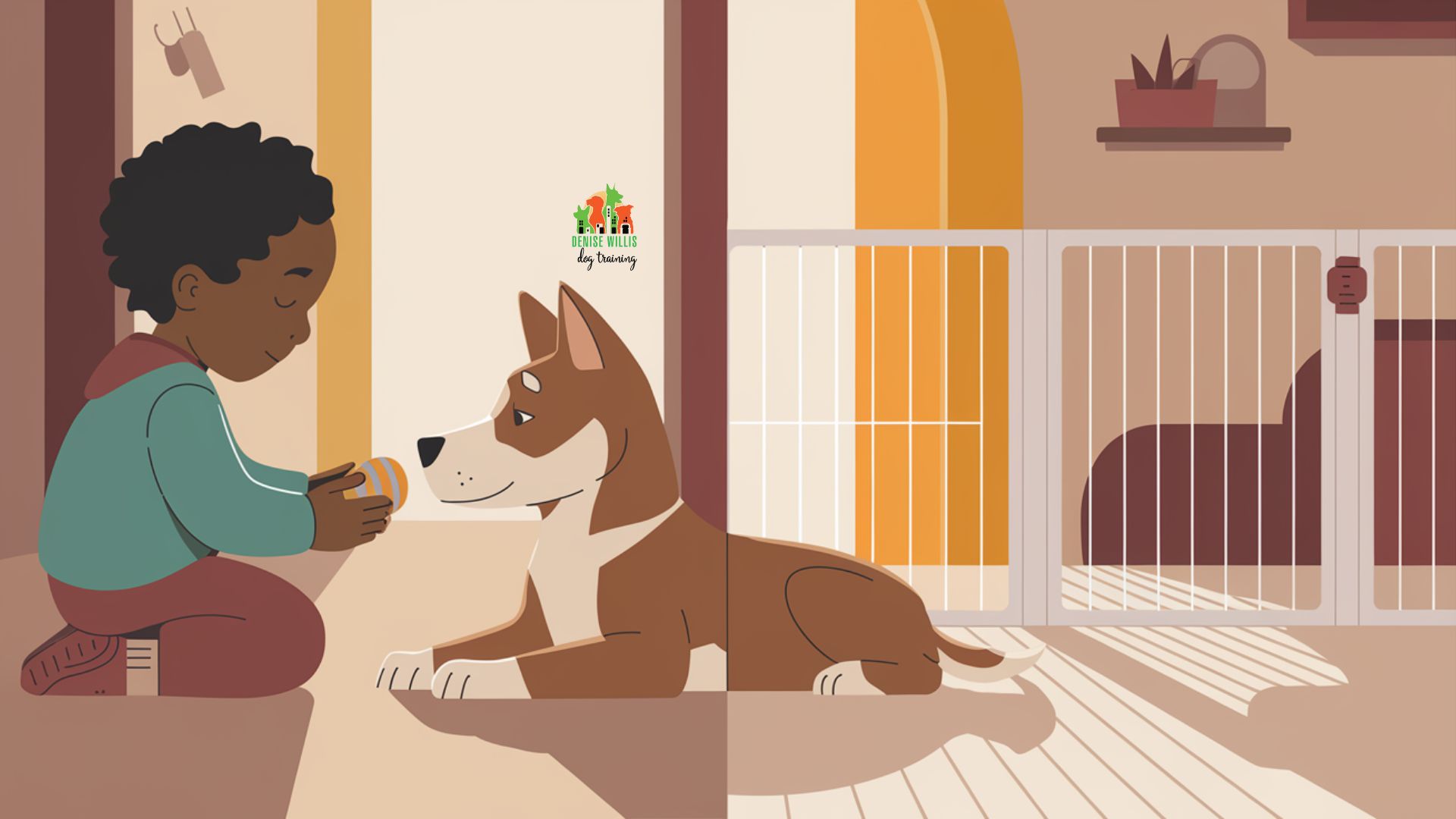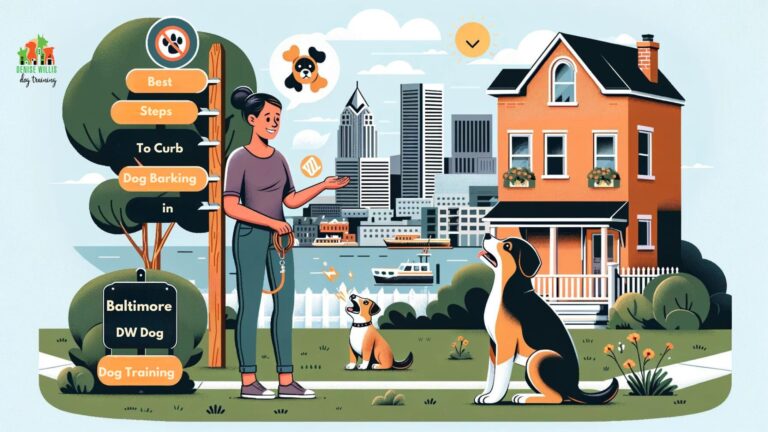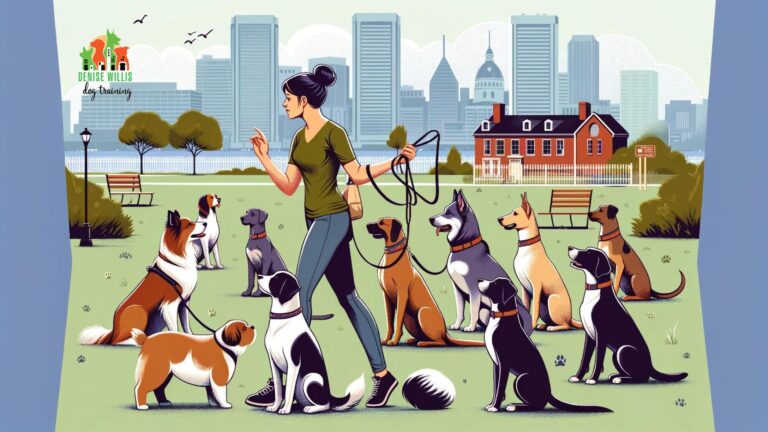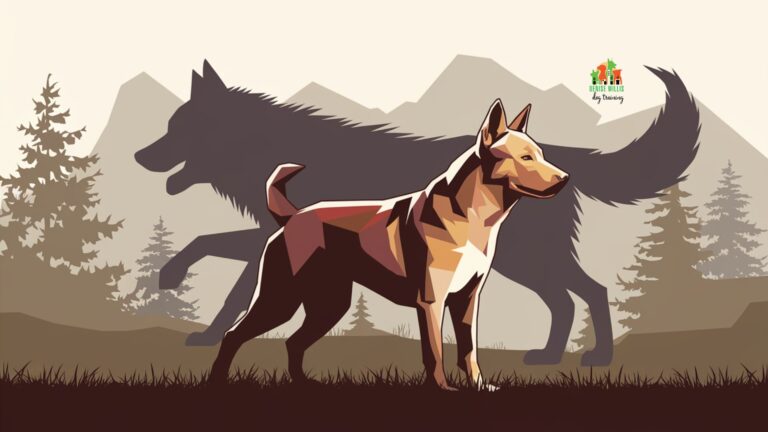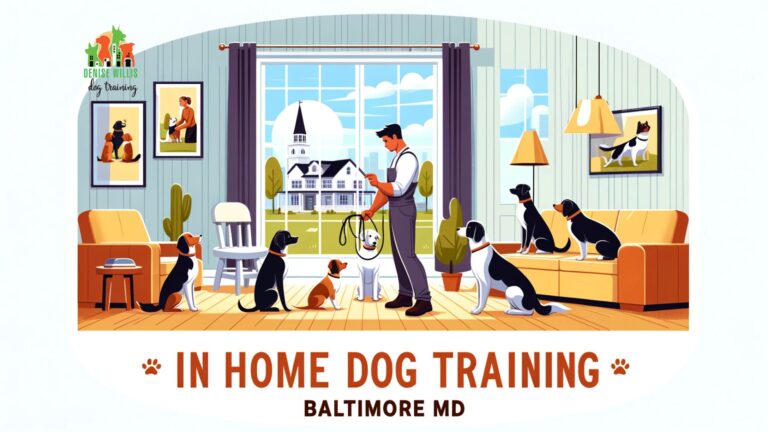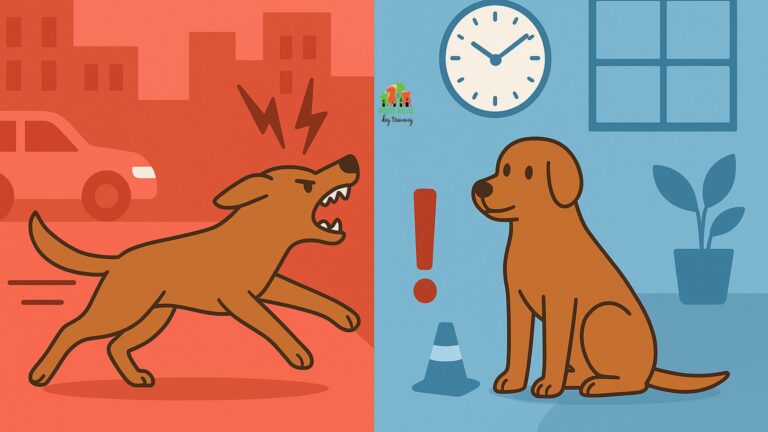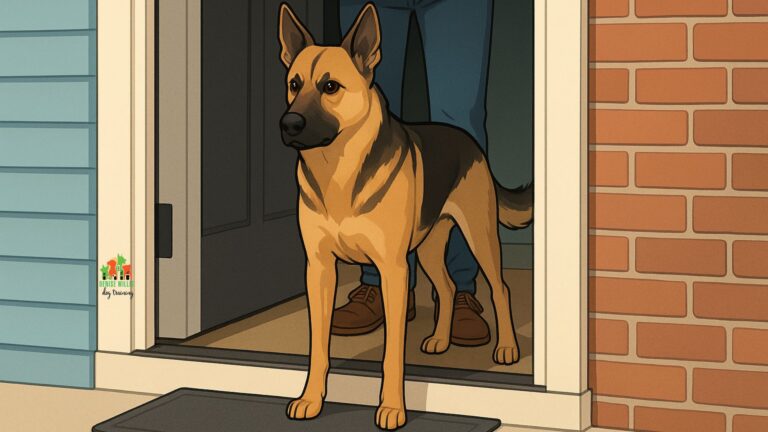9 Crucial Steps to Preventing Aggression Toward Children in Dogs
📍 Service Area Notice: DW Dog Training provides in-person training services exclusively in the Greater Baltimore area. While our blog content is designed to help dog owners internationally, our hands-on training services are locally focused. For readers outside our service area, we hope you find value in our articles and welcome you to reach out with questions!
Remember when keeping kids and dogs apart just meant yelling “Don’t pull the dog’s tail!” across the backyard?
Those were simpler times. These days, with families juggling multiple pets, packed schedules, and constant visitors, preventing dog aggression toward children feels more like conducting a symphony orchestra – if the orchestra was made up of drums and kazoos, and half the musicians were running around in superhero capes.
But here’s the reality check: 33.4% of children get bitten by their own family pets. That’s not a typo – we’re talking about dogs they see every day, not the mysterious neighborhood “beast” behind the fence.
Even more concerning?
The head and neck region accounts for 61.7% of these bites, with hands and arms taking another 20.6% of the hits.
The good news?
Most of these incidents are preventable. Studies show that resource guarding triggers 44% of bites to children, while territorial behavior accounts for another significant chunk. Understanding these triggers is your first step toward preventing dog aggression toward children.
Critical Dog Bite Prevention Statistics
Emergency Response
A dog bite occurs every 75 seconds in the US, with over 1,000 emergency care visits daily
Location Risk
80% of dog bites occur at home, with 77% involving family or friend’s dogs
Psychological Impact
70% of children show concerning behaviors after dog bite incidents, with effects lasting 12+ months
Financial Cost
Insurance claims averaged $50,245 per incident in 2020, with total payouts reaching $854 million
1. Why Dogs and Kids Are Like Oil and Water Sometimes
Imagine that you’re peacefully enjoying your morning coffee when suddenly, a group of squealing, flailing aliens invades your home, and everyone expects you to just deal with it. That’s basically what we’re asking of our dogs when we don’t properly introduce them to children. Dogs like predictability. It helps them feel safe and secure. Kids, bless their hearts, are about as predictable as weather forecasts in spring.
Research shows that 77% of dogs exhibiting aggression towards children have underlying anxiety issues. No surprise there – imagine trying to relax when a tiny human could launch themselves at you at any moment. This anxiety often stems from a lack of proper socialization or past negative experiences.
The Canine Perspective
From your dog’s point of view, children are mysterious creatures who haven’t quite figured out how to act like proper pack members. They move erratically, make high-pitched sounds that could wake the dead, and seem to have no concept of personal space. It’s like dealing with a perpetually caffeinated squirrel who’s learned to walk upright.
Dogs not exposed to children during their critical socialization period may view them as threatening later in life. This period isn’t just a suggestion – it’s a crucial window of opportunity. Think of it as your dog’s freshman orientation to the world of tiny humans. Miss it, and you’re playing catch-up forever.
Common Triggers That Make Dogs Say “Nope”
Understanding what sets your dog off is half the battle. Here’s what makes most dogs reconsider their life choices:
Sudden movements top the list – those lightning-fast toddler dashes can trigger even the most patient pup’s prey drive. Add in high-pitched squeals that make dog ears want to retire early, and you’ve got a recipe for stress.
Resource guarding isn’t just about food bowls anymore. That sacred chicken nugget your toddler dropped? It’s a potential trigger. Dogs guard everything from favorite toys to their preferred napping spots. And let’s be honest, who hasn’t gotten a little grumpy when someone disturbs their perfect couch groove?
Space invasion is another biggie. Just like you don’t appreciate strangers invading your personal bubble at the grocery store, dogs need their boundaries respected. Those well-meaning but overly enthusiastic kid hugs?
About as welcome as a surprise dental exam.
2. Life With Multiple Dogs and Kids: A Juggling Act
Managing multiple dogs with children isn’t just a circus act – it’s a circus act where someone keeps adding more rings while you’re trying to juggle. The more dogs in the home, the more “in charge” the human pack members must be. That doesn’t mean channeling your inner drill sergeant. Think less boot camp commander and more skilled orchestra conductor – everyone plays their part, but someone needs to keep the beat.
Managing Your Furry Brady Bunch
First things first: you’re the ringmaster of this show. No pressure, but everyone’s looking to you for cues about what’s okay and what’s not. Studies show that successful pack management requires clear leadership from human family members. This isn’t about being the “alpha” – it’s about being the responsible adult who makes sure nobody eats the Legos.
Setting up your space properly makes a world of difference. Think of it as creating a canine-kid floor plan that would make an interior designer proud. Using baby gates and crates for controlled interactions isn’t just helpful – it’s essential. These aren’t punishment tools; they’re more like private cabanas where everyone can take a break from the family pool party.
Structured routines matter more than you might think. Dogs thrive on predictability – it’s like their version of checking tomorrow’s weather forecast. When they know what to expect, their stress levels drop faster than a hot dog at a picnic. Regular feeding times, exercise sessions, and quiet periods help everyone stay on their best behavior.
When More is Not Always Merrier
Multiple dogs mean multiple personalities, and just like your high school cafeteria, not everyone’s destined to be best friends. Smart management includes understanding that sometimes, separation isn’t just okay – it’s necessary.
Implementing scheduled breaks during chaotic times can prevent most problems before they start. Think of it as mandatory meditation time for your furry friends. While the kids are having their afternoon snack tornado in the kitchen, maybe the dogs get some quality chill time in their rooms with a stuffed Kong.
Evolution of Dog Training and Child Safety
Ancient History – 9000 BCE
First documented evidence of human-canine partnerships, with dogs serving as hunting assistants. This marks the beginning of our long history of working relationships with dogs.
1800s Victorian Era
Training methods dominated by corporal punishment and force-based techniques, reflecting the harsh disciplinary attitudes of the Victorian era.
Early 1900s
Revolution in dog training through Pavlov’s classical conditioning research. Conrad Most publishes the first systematic dog training manual, introducing more structured approaches.
1930s-1940s
Blanche Saunders pioneered obedience training for pet dogs. Military dog training programs during WWII led to significant advances in training techniques.
1970s-1980s
First major awareness campaigns about dog aggression toward children launched. Behavior-based training approaches gain popularity, with increased focus on early socialization.
1990s-2000s
Development of comprehensive bite prevention programs and introduction of legislation regarding dog bite incidents. Enhanced focus on puppy socialization protocols.
2010s-Present
Integration of behavioral science in dog training, with evidence-based methods becoming standard. Development of specialized protocols for child-dog interactions and widespread promotion of child safety techniques.
3. Age-Specific Survival Guide
Different ages bring different challenges, and what works for a newborn won’t cut it with a rampaging toddler. Think of it like updating your phone’s operating system – each new version requires different features and security measures. Research shows that children under 6 years old are particularly vulnerable to dog bites, not because they’re extra tasty, but because they haven’t mastered the art of reading dog body language or respecting personal space. Let’s break down how to keep everyone safe at each stage of the tiny human adventure.
Babies: The Tiny Human Challenge
Adding a baby to the mix? Your dog didn’t sign up for this plot twist. Essential protocols include never leaving infants unattended with dogs – not even for that “quick” diaper grab. It’s like the first rule of Baby Club.
Creating positive associations with baby-related items starts before the tiny human arrives. Let your dog investigate that new stroller like it’s a CSI crime scene. Research shows that maintaining the dog’s routine during transitions significantly reduces stress. Your schedule might be chaos, but your dog’s dinner time shouldn’t be.
Using physical barriers like gates and playpens isn’t helicopter parenting – it’s smart management. Think of it as creating buffer zones where everyone can feel secure. Your dog gets their space, your baby gets their space, and you get fewer gray hairs.
Toddlers: The Walking Tornado Years
Ah, toddlers – nature’s way of testing everyone’s patience, including the family dog. Key considerations for this age include supervising all interactions and teaching appropriate touching. “Gentle hands” becomes your new mantra, repeated more often than your favorite coffee order.
Implementing “wait” commands isn’t just good manners – it’s a safety essential. Teach your toddler that approaching the dog is like crossing the street: we stop, we look, and we check if it’s safe first. Meanwhile, your dog learns that staying calm when the tiny tornado approaches means good things happen.
Creating safe spaces for both toddlers and dogs sounds like a real estate challenge, but it’s simpler than you think. Your dog needs their equivalent of a man cave or she shed – a place where they can retreat when the toddler’s “help” becomes too helpful. Similarly, your toddler needs play areas where they can release their inner wild child without giving your dog anxiety.
Exercise becomes your secret weapon during these years. A well-exercised dog has better tolerance for toddler shenanigans. Think of it as filling up their patience tank before the day begins. A tired dog is usually a more tolerant dog, just like how you’re more patient after your morning coffee.
4. Common Scenarios That Make Dogs Say “Nope”
Even the most well-trained dog can have their patience tested by certain situations. It’s like putting an introvert at a surprise party – technically they can handle it, but wouldn’t it be nicer if they had some warning and an escape plan? Managing excitement levels and maintaining routines during high-stress periods is crucial for preventing aggressive incidents. Let’s tackle some of the most common scenarios that make dogs question their life choices.
Holiday Chaos Control
The holidays – when everyone’s stress levels compete for new heights and your dog wonders why their normally predictable home turned into Grand Central Station. Studies show that maintaining regular routines despite visitors significantly reduces stress-related incidents. Think of it as keeping your dog’s emotional bank account in the black during the season of excess.
Setting up quiet retreat spaces becomes more crucial than ever during these times. Your dog needs their version of that peaceful bathroom break you take to escape Aunt Martha’s endless stories about her cat’s dietary preferences. A dedicated space, whether it’s a crate decked out like a cozy den or a gated-off room, gives your dog the option to say “thanks, but I need a minute” without using their teeth to make the point.
Briefing guests on house rules isn’t being a party pooper – it’s being a responsible pet parent. Yes, even if that means telling your mother-in-law that no, the dog doesn’t want to wear the reindeer antlers she bought specially for this occasion. Clear boundaries with visitors help prevent most holiday-related incidents.
Family Visits Without the Drama
Nothing tests a dog’s patience quite like a houseful of visitors who all have their own ideas about how dogs should behave. Setting clear boundaries with guests isn’t just helpful – it’s essential for preventing stress-related aggression. Your house, your rules, even if Cousin Eddie insists that dogs love being bear-hugged while they’re eating.
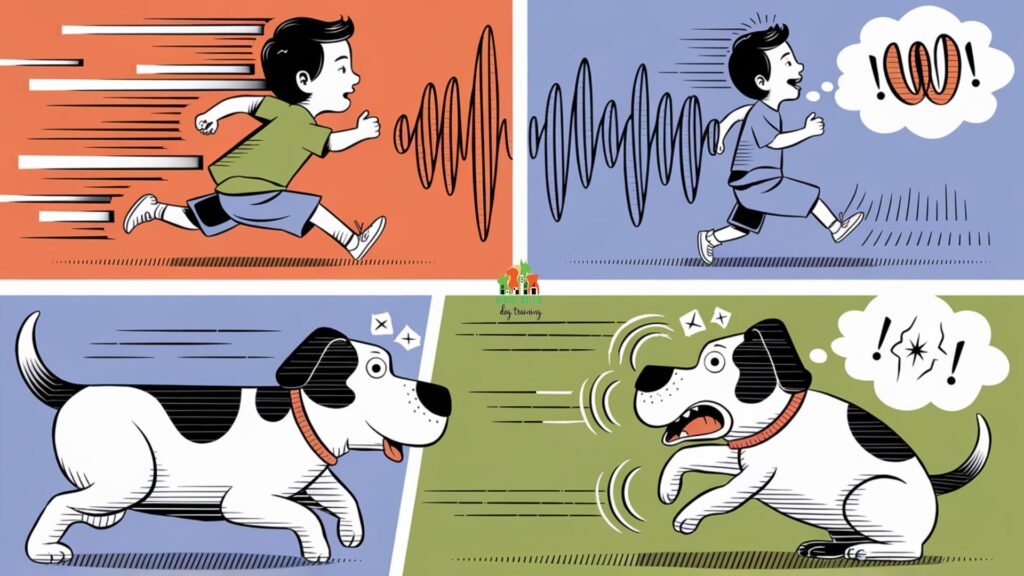
The Numbers That’ll Make You Sit and Stay
Think your protective pup is just being extra cautious? The statistics tell a tale that’s more dramatic than a soap opera marathon. Before you dismiss those growls or “minor” incidents, let’s look at some numbers that’ll make your tail curl – and not in the cute puppy way.
| Category | Statistic | Notes | Source |
|---|---|---|---|
| Emergency Care Frequency | Every 75 seconds | Frequency of dog attack occurrences in the United States | [2] |
| Daily Emergency Care | 1,000+ cases | Number of citizens requiring emergency care for dog bite injuries daily | [2] |
| Home Incidents | 80% | Percentage of dog bites occurring at home | [2] |
| Known Dog Cases | 77% | Percentage of biting dogs belonging to victim’s family or friends | [2] |
| Psychological Impact | 70% | Percentage of children showing concerning behaviors post-bite incident | [3] |
| Insurance Claims | $854 million | Total insurance payouts for dog bite injuries in 2020 | [5] |
| Average Claim Cost | $50,245 | Average insurance claim amount for dog bites in 2020 | [5] |
If those statistics made your heart skip a beat faster than a squirrel spotting a treat, you’re not alone. We’re talking about incidents happening more frequently than your Amazon deliveries (every 75 seconds!), and mostly in places we consider safe – our own homes. It’s like discovering your favorite comfort food has been secretly plotting against you all along.
But here’s the silver lining.
Armed with this knowledge, you’re already halfway to preventing your family from becoming part of these statistics. Think of it as having the cheat codes to the video game of life with dogs and kids. And unlike those impossible-to-beat final boss levels, this is one challenge you can absolutely master with the right strategies.
Ready to turn those statistics into “not in my house” stories? Let’s dive into some practical prevention strategies that’ll make your home safer than Fort Knox (but way more fun).
5. The “Please Don’t Bite Junior” Prevention Plan
Prevention isn’t just better than cure – it’s easier, cheaper, and involves way less paperwork. Creating a safe environment where both kids and dogs can thrive takes some planning, but it’s worth every minute spent. Think of it as installing a security system for your family’s peace of mind, except this one runs on positive reinforcement and clear boundaries instead of batteries.
Management Techniques That Actually Work
Let’s face it – hoping everyone will just get along isn’t a strategy, it’s a wish list item. Professional behaviorists emphasize that proper management prevents most aggressive incidents before they can start. This means creating an environment where both dogs and kids can exist without constantly testing each other’s patience.
Baby gates become your new best friends – think of them as force fields that maintain peace throughout the galaxy (or at least throughout your house). Strategic placement of these barriers can prevent everything from resource guarding incidents to unwanted snack-sharing attempts.
Training Beyond “Sit” and “Stay”
Basic obedience is great, but preventing aggression requires a more sophisticated toolkit. Research indicates that dogs who have clear behavioral expectations and consistent training show significantly fewer stress-related behaviors. This means teaching your dog more than just party tricks – they need to learn how to cope with the chaos that comes with living with children.
Teaching solid “leave it” and “place” commands isn’t just showing off at the dog park – these are critical safety skills. When your toddler drops their sandwich for the third time in five minutes, you’ll be thankful your dog knows that “leave it” means “yes, even though it’s technically on the floor now.”
6. Reading Your Dog’s “I’m Not Cool With This” Signals
Dogs are constantly communicating with us, but sometimes we’re about as good at reading their signals as we are at reading terms and conditions before clicking “agree.” Understanding canine body language can prevent up to 77% of bite incidents, making it one of your most powerful tools for keeping peace in the kingdom. Think of it as learning your dog’s emotional traffic lights before someone runs a red signal.
Body Language 101
Ever wish your dog came with subtitles?
While we can’t give them a voice-over, we can learn their visual language. Research shows that dogs always give warning signs before escalating to aggressive behavior. The trick is catching these signals before things go south.
When your dog licks their lips and there’s no food in sight, they’re not thinking about dinner. This is their version of saying “Um, could we not?” The same goes for turning their head away – it’s the canine equivalent of pretending not to hear when someone suggests karaoke at the office party.
That “guilty” yawn during non-nap times?
Not tiredness. Your dog is channeling their inner meditation guru, trying to calm themselves when they’re stressed. And when they show the whites of their eyes (whale eye), they’re not practicing for a dramatic soap opera scene – they’re saying “I’m really uncomfortable right now.”
Warning Signs That Shouldn’t Be Ignored
If body language had volume controls, these would be your dog’s way of turning it up to eleven. When dogs progress to more obvious warning signs, the risk of biting increases significantly. Think of these as your dog’s version of caps lock – they’re not just suggesting you back off, they’re insisting.
A stiff, frozen posture isn’t your dog practicing for a mannequin challenge. It’s their version of a stop sign, complete with flashing lights. Add a low growl to that statue impression, and you’ve got the canine equivalent of a tornado warning – take shelter and make changes immediately.
7. Emergency Game Plan
Nobody plans to have their dog bite someone, just like nobody plans to need their car’s airbags. But having a solid plan in place can make the difference between a minor incident and a major crisis. Documentation and immediate response protocols significantly improve outcomes in bite incidents. Let’s break down what you need to know before you need to know it.
When Things Go South
The moment an incident occurs, time seems to slow down and speed up simultaneously. Having a clear action plan helps you navigate those crucial first moments with the precision of a professional crisis manager (even if you’re internally screaming).
First priority: separate dogs and kids faster than a toddler can find unattended markers. Immediate separation prevents escalation and allows for proper assessment of any injuries. This isn’t about placing blame – it’s about ensuring everyone’s safety.
Document everything while it’s fresh in your mind, like a detective at a crime scene.
What happened right before?
Was there food involved?
Did someone try to hug the dog while they were sleeping?
These details matter more than you might think for preventing future incidents.
After the Incident
Once the immediate crisis has passed, it’s time for some CSI-level investigation (minus the dramatic sunglasses removal). Professional evaluation following a bite incident can identify underlying causes and prevent future occurrences.
Think of this like a car accident – even if everyone seems fine, you still want a professional to check things out. A qualified behaviorist can help you understand what went wrong and create a roadmap for preventing future incidents. Sometimes the trigger isn’t what you think it is, like blaming traffic for being late when your alarm never went off.
8. Training Programs That Actually Work
If preventing dog aggression was as simple as watching a few YouTube videos, we’d all be professional trainers by now. Reality check: professional guidance significantly increases success rates in managing and preventing aggressive behavior. Let’s talk about what actually works, minus the social media shortcuts and questionable internet advice.
Available Options That Make a Difference
Every dog is unique – like snowflakes, but with teeth and anxiety. Individual behavioral assessments form the foundation of successful training programs. This isn’t one-size-fits-all territory; it’s more like having a custom suit made, except instead of measuring inseams, we’re measuring tolerance levels.
Family training becomes crucial because let’s face it – your dog isn’t the only one who needs to learn new tricks. Teaching everyone in the household proper interaction skills is like giving the whole family the same user manual. No more mixed messages about whether the couch is furniture or a trampoline.
Management consultations might sound fancy, but they’re really about making your home work for everyone who lives there. Think of it as having a lifestyle coordinator for your pet-and-kid circus.
The goal?
Creating an environment where nobody feels the need to audition for Animal Planet’s newest drama series.
9. Seasonal Stress Management
Just when you think you’ve got everything under control, the calendar throws you a curveball. Each season brings its own special brand of chaos, and your dog notices every single change. Seasonal changes can significantly impact dog behavior and stress levels, making consistent management more important than ever.
Holiday Survival Guide
The holidays aren’t just stressful for humans trying to remember which relative is vegan this year. Maintaining regular routines during holiday chaos prevents most stress-related incidents. Your dog doesn’t care about your aunt’s opinion on your decorating choices, but they do care about getting their walk at the usual time.
Extra exercise becomes your secret weapon during these high-stress periods. Think of it as filling up your dog’s patience tank before the relatives arrive. A tired dog is less likely to object to cousin Tommy’s twentieth rendition of “Jingle Bells” on his new kazoo.
Vacation Planning
Whether you’re staying home or adventuring elsewhere, planning ahead prevents most drama. Consistent rules and routines help dogs cope with schedule changes, even if those changes involve trading their regular backyard for a beach view.
Product Recommendations
The quest to keep kids and canines in harmony can feel like directing traffic at a circus parade. But fear not! We’ve rounded up some essential gear that’s more useful than a Swiss Army knife at a camping trip. Let’s turn that protective pooch into the family’s favorite peace keeper!
- ThunderShirt Classic Dog Anxiety Jacket: When your furry friend thinks they’re head of homeland security, wrap them in this anxiety-reducing wonder. It’s like a warm hug from a very persistent octopus, turning guard dogs into cuddle bugs. Warning: May cause your dog to become so zen they start teaching meditation classes to the neighborhood squirrels.
- Enrichment Puzzle Dog Toy by Nina Ottosson: Give your pup’s brain something better to do than monitor the kids’ every move. It’s like “Escape Room: Doggy Edition” – complete with hidden treats and sliding panels. Caution: Your dog may become so good at puzzles they start doing your kids’ homework.
- Dog Gate with Walk Through Door: Create peace zones in your home with this sturdy barrier. It’s like having an invisible butler who politely says “Not now” to both furry and tiny humans. Warning: May cause your toddler to believe they’re living in a royal palace with different chambers.
- KONG Classic Dog Toy: The Swiss Army knife of dog distractions! Perfect for keeping your pup busy while the kids do their thing. It’s like a pacifier for dogs, but with peanut butter. Caution: Your dog may start expecting everything in life to be stuffed with treats.
- High-Value Dog Training Treats: These tiny rewards are your secret weapon in teaching dogs and kids to coexist. They’re like doggy currency – small enough to fit in your pocket, valuable enough to change behavior. Warning: Your dog may start expecting payment for basic services like existing.
Remember folks, while these products won’t magically transform your protective pooch into a certified babysitter, they’ll certainly make the journey more manageable. And hey, at least nobody’s suggested putting the kids in a ThunderShirt… yet!
Further Reading
Think you’ve got a handle on your dog’s protective instincts? Well, hold onto your leash because there’s more to learn! These articles are packed with more wisdom than a fortune cookie factory. (Just don’t let your dog eat either.)
- 10 Warning Signs Your Dog Might Bite and How to Prevent It: Decode your dog’s secret signals before things get toothy! Learn to read your pup like a book – a much easier read than “War and Peace,” we promise. Spoiler alert: If your dog starts speaking in Morse code, you’ve probably missed a few earlier signs.
- Decoding Your Dog: 15 Body Language Signals You Need to Know: Finally, a translation guide that doesn’t require a degree in animal psychology! From tail positions to ear angles, become fluent in Dog-lish. Warning: May result in you unconsciously tilting your head when confused.
- How to Manage Your Dog’s Territorial Aggression: Is your dog trying to claim the entire house as their personal empire? Learn how to negotiate better borders than a UN diplomat. Bonus: Includes tips on explaining property laws to your furry friend.
- 10 Simple Steps to Prevent Resource Guarding in Puppies: Turn your canine hoarder into a sharing superstar! Because nobody wants a dog who guards the toilet paper like it’s made of gold. Spoiler: Treats are involved. Many, many treats.
- The Shy Dog’s Guide to Conquering Fear: 10 Simple Techniques: Help your nervous nellie become a confident Cassandra! These techniques are like therapy for dogs, minus the couch and hourly rates. Warning: Success may result in a dog who starts giving pep talks to other nervous pups at the park.
Don’t stop now – your journey to becoming the Dog Whisperer of your household is just beginning!
These articles will take you from “What was that growl about?” to “I speak fluent dog” faster than your pup can hide your favorite shoe. Just remember to bring treats. Lots of treats.
Frequently Asked Questions
Q: How do I know if my dog is just playing or actually aggressive?
A: Play includes loose, bouncy movements and play bows. Aggression shows stiff postures and intense staring. Think of it as the difference between a dance party and a standoff in an old Western movie.
Q: What should I do if my dog growls at my child?
A: First, thank your dog for using their words instead of their teeth. Growling is communication, not defiance. Separate them calmly and contact a professional trainer. Punishing growls is like removing the batteries from your smoke detector because you don’t like the noise.
Q: Can aggressive dogs be rehabilitated?
A: Most cases of aggression can be managed successfully with proper professional guidance. Success depends on commitment to training and consistent management. Think of it as rehabilitation, not a miracle cure.
Test Your Knowledge: Preventing Dog Aggression Toward Children
Final Thoughts
Creating harmony between dogs and kids isn't about luck or hoping for the best. It's about understanding, management, and consistent training. At DW Dog Training, we've seen countless families transform from walking on eggshells to confidently managing their multi-species households.
Remember, every dog and every family is unique. What works for your neighbor's perfectly behaved Poodle might not work for your anxiety-prone Shepherd mix. That's okay. We're here to help you find your family's perfect balance.
Ready to create a safer, happier household for both your two-legged and four-legged family members?
Looking to transform those "Oh no!" moments into "I got this" confidence?
Let's work together to make it happen. Because at DW Dog Training, we believe every dog deserves the chance to be their best self, and every family deserves to feel safe and happy together.
Share Your Story
Has your nervous Nellie become a confident Cassandra?
Maybe your resource guarder now shares toys like a kindergarten teacher?
We want to hear about your journey!
Your experiences could be the lighthouse another family needs while navigating these same waters.
Whether you've conquered the challenge of introducing a new baby to your protective pup or finally mastered peaceful mealtimes with toddlers and dogs, your story matters.
Share your triumphs, your learning moments, and yes, even those "what was I thinking?" adventures. After all, sometimes the best advice comes from those who've already walked the path.
Drop us a line about your experiences, breakthroughs, or ongoing challenges. Your insights might just be the missing piece another family needs to complete their puzzle.
And hey, if you've got photos of your reformed fun police now happily playing hall monitor to the kids, we'd love to see those too!

